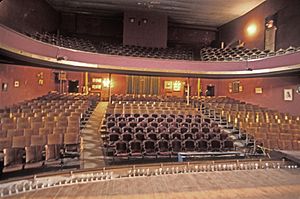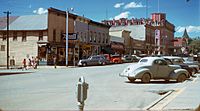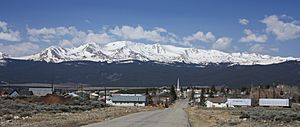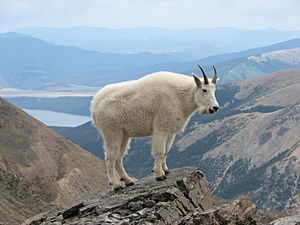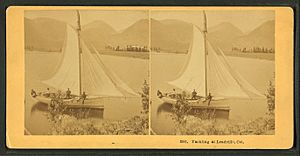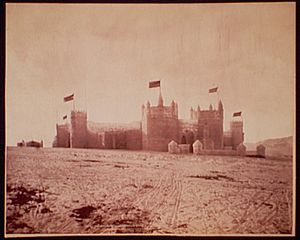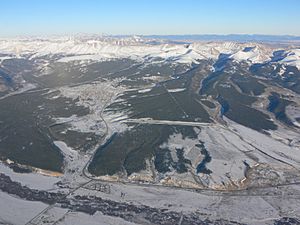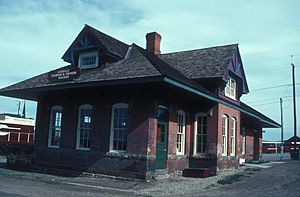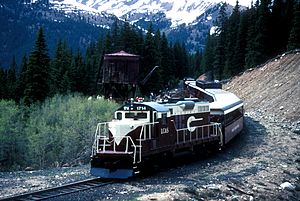Leadville, Colorado facts for kids
Quick facts for kids
Leadville, Colorado
|
|
|---|---|
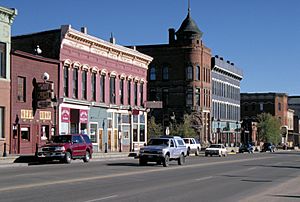
Downtown Leadville
|
|
| Nickname(s):
The Two-Mile-High City, Cloud City
|
|
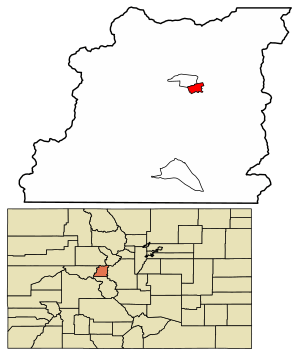
Location of the City of Leadville in Lake County, Colorado
|
|
| Country | United States |
| State | Colorado |
| County | Lake |
| City | Leadville |
| Founded | 1877 |
| Incorporated | February 18, 1878 |
| Government | |
| • Type | Statutory city |
| Area | |
| • Total | 1.17 sq mi (3.04 km2) |
| • Land | 1.17 sq mi (3.04 km2) |
| • Water | 0.00 sq mi (0.00 km2) |
| Elevation | 10,154 ft (3,095 m) |
| Population
(2020)
|
|
| • Total | 2,633 |
| • Density | 2,250/sq mi (866.1/km2) |
| Time zone | UTC−7 (Mountain (MST)) |
| • Summer (DST) | UTC−6 (MDT) |
| ZIP Codes |
80429 (PO Box), 80461
|
| Area code(s) | 719 |
| FIPS code | 08-44320 |
| GNIS feature ID | 2411641 |
|
|
|
Leadville (/ˈlɛdvɪl/ LED-vil) is a statutory city that is the county seat, the most populous community, and the only incorporated municipality in Lake County, Colorado, United States. The city population was 2,633 at the 2020 census. It is situated at an elevation of 10,119 feet (3,084 m). Leadville is the highest incorporated city in the United States and is surrounded by two of the tallest peaks in the state.
Leadville is a former silver mining town that lies among the headwaters of the Arkansas River within the Rocky Mountains. The Leadville Historic District, designated a National Historic Landmark in 1961, contains many historic structures and sites of Leadville's mining era. In the late 19th century, Leadville was the second most populous city in Colorado, after Denver.
Contents
History
Settlement
The Leadville area was first settled in 1859 when placer gold was discovered in California Gulch during the Pikes Peak Gold Rush. By 1860, a town, Oro City ("oro" is the Spanish word for gold) had sprung up and a year later its population had reached more than 5,000. But the boom was brief because the placer-mined gold soon ran out and Oro City never became a major settlement.
The early miners had noted that mining for placer gold was hampered by heavy black sand in the sluice boxes, and in 1874 it was discovered that the heavy sand that impeded gold recovery was the lead mineral cerussite, which has a high silver content. Prospectors traced the cerussite to its source, present day Leadville, and by 1876 had discovered several silver-lead lode deposits.
Horace Tabor, who became known as the "Leadville Silver King" and his wife Augusta were among the first prospectors to arrive in Oro City. Tabor tried his luck at prospecting while his wife worked as a camp cook, laundress, banker and postmistress.
Founding of Leadville
Leadville was founded in 1877 by mine owners Horace Tabor and August Meyer at the start of the Colorado Silver Boom. The town was built on desolate flat land below the tree line. The first miners lived in a rough tented camp near the silver deposits in California Gulch. Initially the settlement was called Slabtown but when the residents petitioned for a post office the name Leadville was chosen. By 1880 Tabor and Meyer's new town had gas lighting, water mains and 28 miles of streets, five churches, three hospitals, six banks, and a school for 1,100 students. Many business buildings were constructed with bricks hauled in by wagons.
The first post office was in Tabor's store at Oro, Augusta Tabor was the postmistress. Carriers went down to Denver one week and tried to come back the next. Postage was fifty cents a letter. In early 1878, Meyer, Harrison, Tabor established a post office in Leadville, with Henderson as postmaster. The post office and the telegraph office both prospered.
The town's first newspaper was The Reveille, a Republican weekly in 1878. Three months later, a competing Democratic weekly, The Eclipse emerged. The Chronicle was the town's first daily and first newspaper in America to employ a full-time female reporter. Like the Rocky Mountain News, The Chronicle took the lead in outing criminals and thieves, in an attempt to clean up the town's shady business culture. Despite violent threats, the Chronicle survived without major incident.
William Nye opened the first saloon early 1877 and it was followed by many others. The same year "The Coliseum Novelty" was the first theater to open. It offered sleeping rooms upstairs for a nightly rate and provided a variety of entertainments: dancing girls, dogfights, cockfighting, wrestling and boxing matches, as well as rooms for gambling. In June 1881, it burned to the ground. Ben Wood who arrived in Leadville in 1878, opened the first legitimate theatre,Wood's Opera House with a thousand seats. It was a first- class theater, where gentleman removed their hats and did not smoke or drink in the presence of a lady. Less than a year later, Wood opened the Windsor Hotel. His opera house was regarded as the largest and best theater constructed in the west, an honor it held until the opening of the Tabor Opera House. Horace Tabor's Opera House was the most costly structure in Colorado at the time. Building materials were brought by wagons from Denver. The massive three-story opera house, constructed of stone, brick, and iron, opened on 20 November 1879. Tabor, originally from Vermont, became the town's first mayor. After striking it rich, he had an estimated net worth of 10 million dollars and was known for his extravagant lifestyle.
In 1883 Horace Tabor divorced his wife of 25 years, and married Baby Doe McCourt, who was half his age. Tabor was by then a US senator and the divorce and marriage caused a scandal in Colorado and beyond. Tabor, one of the wealthiest men in Colorado, lost his fortune when the repeal of the Sherman Silver Purchase Act caused the Panic of 1893. He died destitute but convinced the price of silver would rebound, and according to legend told Baby Doe to "hold on the Matchless mine … it will make millions again when silver comes back." She returned to Leadville with her daughters, Silver Dollar and Lily, where she spent the rest of her life believing Tabor's prediction. At one time the "best dressed woman in the West", she lived in a cabin at the Matchless Mine for the last three decades of her life. After a snowstorm in March 1935, she was found frozen in her cabin, aged about 81 years.
Mining and smelting
By 1880, three years after the town was founded, Leadville was one of the world's largest and richest silver camps, with a population of more than 15,000. Income from more than thirty mines and ten large smelting works producing gold, silver, and lead amounting to $15,000,000 annually.
According to Lincoln H. Hall, "The outpouring of the precious metal from Leadville transformed the struggling Centennial State into a veritable autocrat in the colony of states. As if by magic the rough frontier town of Denver became a metropolis; stately buildings arose on the site of shanties; crystal streams flowed through the arid plains and the desert blossomed and became fruitful. Poverty gave way to the annoyance of wealth and the fame of silver state spread throughout the world." (Conant, 106)
Swindles were not uncommon in the mining community. When the Little Pittsburg mine was exhausted of its rich ore body, its managers sold their shares while concealing the mine's actual condition from the other stockholders. "Chicken Bill" Lovell dumped a wheelbarrow load of silver-rich ore into a barren pit on his Chrysolite claim in order to sell it to Horace Tabor for a large price. Tabor had the last laugh when his miners dug a few feet farther and discovered a rich ore body. Some time later the manager of the Chrysolite mine fooled an outside mining engineer into overestimating the mine's ore reserves.
The city's fortunes declined with the repeal of the Sherman Silver Purchase Act in 1893, although afterwards there was another small gold boom. Mining companies came to rely increasingly on income from the lead and zinc. The district is credited with producing over 2.9 million troy ounces of gold, 240 million troy ounces of silver, 1 million short tons of lead, 785 thousand short tons of zinc, and 53 thousand short tons of copper.
A bitter strike by Leadville's hard rock miners in 1896–97 led to bloodshed, at least five deaths, and the burning of the Coronado Mine.
World War II caused an increase in the demand for molybdenum, used to harden steel. It was mined at the nearby Climax mine, which at one time produced 75 percent of the world's output. By 1980 The Climax Mine was the largest underground mine in the world. Taxes paid by the mine provided Leadville with good schools, libraries, and provided employment for many residents. When the market dropped in 1981, Leadville's economy suffered and many people lost their jobs. With little industry other than the tourist trade, most of the former miners left and the standard of living declined. Climax reopened in 2008 and started production in 2010. It currently is the most efficient mine producing the metal in Colorado and estimated to have a production life of thirty years.
Leadville's colorful past
As the population boomed, by 1878 Leadville had the reputation as one of the most lawless towns in the West. The first city marshal was run out of town a few days after he was appointed and his replacement was shot dead within a month by one of his deputies. Fearing the town would be lost to the lawless element, Mayor Horace Tabor sent for Mart Duggan, who was living in Denver, as a replacement. Duggan is little-known today, but was well known as a fearless gunfighter. Using strong-arm and lawless tactics, during his two stints as marshal Duggan brought order to Leadville by 1880 when he stepped down. He was shot and killed in 1889 by an unknown assailant, most likely an enemy he had made when he was a Leadville marshal.
Alice Ivers, better known as Poker Alice, was a card player and dealer of the Old West who learned her trade in Leadville. Born in Devonshire, her family moved to America when she was a small girl. They first settled in Virginia where she attended an elite girl's boarding school. When she was a teenager her family moved to Leadville when the silver boom drew hundreds of new residents to the area. At the age of twenty she married a mining engineer who, like many of the men at that time, frequented the numerous gambling halls in Leadville. Alice went along, at first just observing, but eventually she began to sit in on the games as well. After a few years of marriage her husband was killed in a mining accident and she turned to cards to support herself. Alice was attractive, dressed in the latest fashions, and was in great demand as a dealer. Eventually Alice left Leadville to travel the gambling circuit, as was common of the male gamblers of that time. She continued to dress in the latest fashions but took to smoking cigars. Well known throughout the West, gambling halls welcomed her because she was good for business. In her later years, Alice claimed to have won more than $250,000 at the gaming tables and never once cheated.
Texas Jack Omohundro, Confederate scout, cowboy and stage actor with "Buffalo Bill" Cody's travelling revue, died of pneumonia a month before his 34th birthday in summer 1880 in Leadville where he was living on a small estate with his wife, ballerina Giuseppina Morlacchi.
Around 1883, shortly after the gun fight at the O.K. Corral, outlaw Doc Holliday moved to Leadville. On 19 August 1884, he shot ex-Leadville policeman, Billy Allen, who had threatened him for failing to pay a $5 debt. Despite overwhelming evidence implicating him, a jury found Holliday not guilty of the shooting or attempted murder.
Gunfighter and professional gambler Luke Short also spent time in Leadville.
Margaret "Molly" Brown, who became known as "The Unsinkable Molly Brown", moved to Leadville when she was 15. In 1886 she married a mining engineer who was twice her age, James J. Brown. The Brown family acquired great wealth in 1893 when Brown was instrumental in the discovery of a substantial ore seam at the Little Jonny Mine owned by his employers, the Ibex Mining Company. Molly became famous because of her survival of the 1912 sinking of the RMS Titanic, after exhorting the crew of Lifeboat No. 6 to return to look for survivors. A 1960 Broadway musical based on her life was produced, along with a 1964 film adaptation of the musical, both titled The Unsinkable Molly Brown.
June Mathis, a pioneer screenwriter and first female executive for the MGM film studio, credited for discovering matinee idol Rudolph Valentino, was born in Leadville.
Oscar Wilde appeared at the Tabor Opera House during his 1882 American Aesthetic Movement lecture tour. The reviews were mixed and the press satirized Wilde in cartoons as an English dandy decorated with sunflowers and lilies, the floral emblems of the Aesthetic Movement.
Post-mining era
The many years of mining left behind substantial contamination of the soil and water, so that the Environmental Protection Agency designated some former mining sites as Superfund sites, such as California Gulch.
The town has made major efforts to improve its economy by encouraging tourism and emphasizing its history and opportunities for outdoor recreation. The National Mining Museum and Hall of Fame opened in 1987 with a federal charter. The town's altitude and rugged terrain contributes to a number of challenging racing events, such as the Leadville Trail 100 series of races. It is often used as a base for altitude training and hosts a number of other events for runners and mountain bicyclists.
Geography
Although a few higher unincorporated settlements exist, Leadville is the highest incorporated city in the United States. At an elevation of 10,152 ft (3,094 m), it lies right at the edge of timberline, which in Colorado is from 11,000 to 12,000 feet. The surrounding peaks are all well above 12,000, thus they are all bare of trees.
Leadville lies in a valley at the head waters of the Arkansas River which flows through the southern Rocky Mountains and eventually empties into the Mississippi River. It is situated between two mountain ranges, the Mosquito Range to the east and the Sawatch Range to the west; both of which include several nearby peaks with elevations above 14,000 feet, the so-called fourteeners. Mount Elbert, about 16 miles southwest of Leadville, is the highest summit of the Rocky Mountains of North America and the highest point in the Colorado and the entire Mississippi River drainage basin. An ultra-prominent 14,440-foot (4,401 m) fourteener, Mount Elbert is the highest summit of the Sawatch Range and the second-highest summit in the contiguous United States after Mount Whitney. Mount Massive, 10.6 miles (17.1 km) west-southwest of Leadville, at 14,428-foot (4,398 m) is the second highest summit in the Rocky Mountains and state of Colorado, and the third highest in the contiguous United States.
Turquoise Lake lies on the northern outskirts of Leadville. The surface available for recreation includes 780 acres. Turquoise Lake is a feature of the Fryingpan-Arkansas Project. Recreation is managed by the Forest Service for Reclamation as part of the San Isabel National Forest.
Demographics
| Historical population | |||
|---|---|---|---|
| Census | Pop. | %± | |
| 1880 | 14,820 | — | |
| 1890 | 10,384 | −29.9% | |
| 1900 | 12,455 | 19.9% | |
| 1910 | 7,508 | −39.7% | |
| 1920 | 4,959 | −34.0% | |
| 1930 | 3,771 | −24.0% | |
| 1940 | 4,774 | 26.6% | |
| 1950 | 4,081 | −14.5% | |
| 1960 | 4,008 | −1.8% | |
| 1970 | 4,314 | 7.6% | |
| 1980 | 3,879 | −10.1% | |
| 1990 | 2,629 | −32.2% | |
| 2000 | 2,821 | 7.3% | |
| 2010 | 2,602 | −7.8% | |
| 2020 | 2,633 | 1.2% | |
| U.S. Decennial Census | |||
Arts and culture

Historic sites and districts
The Leadville Historic District was designated a National Historic Landmark District in 1961. The district encompasses 67 mines east of the city up to the 12,000-foot (3,700 m) elevation, and a defined portion of the village area, with specific exclusions for various buildings. The principal historic buildings are the Tabor Grand Hotel, St George's Church, Temple Israel, African Methodist Episcopal Church (est. 1881)African Methodist Episcopal Church (est. 1881), the Annunciation Church, Tabor Opera House, City Hall, Healy House, Dexter Cabin, Engelbach House, Tabor House, and the Golden Burro Cafe and Lounge, as well as mining structures and small homes.
The National Mining Hall of Fame on West 9th Street is dedicated to commemorating the work of miners and people that work with natural resources. It is listed on the National Register of Historic Places. Major exhibits include an elaborate model railroad, a walk-through replica of an underground hardrock mine, the Gold Rush Room with specimens of native gold, a large collection of mineral specimens, and a mining art gallery. The site also includes the Matchless Mine and cabin, former home of Baby Doe Tabor.
Some historic sites are linked by the Mineral Belt National Recreation Trail, an 11.6-mile (18.7 km) all-season biking/walking trail that loops around Leadville and through its historic mining district. In part it follows old mining-camp railbeds. Interpretative kiosks recount the history and a photograph of what was on that particular site more than a century ago. The trail is well-marked with interpretive signs and altitude and mileage markers.
Created by Executive Order in 1889 to increase the supply of fish for inland waters, the Leadville National Fish Hatchery was established.
Camp Hale is located 15 miles (24 km) north of Leadville in the Eagle River valley north of Tennessee Pass. It was a U.S. Army ski warfare training facility constructed in 1942 for what became the 10th Mountain Division. Some of the nation's finest skiers were employed as instructors. Soldiers were trained in mountain climbing, Alpine and Nordic skiing, and cold-weather survival, as well as various weapons and ordnance. When it was in full operation, approximately 15,000 soldiers were housed there. As the only source of recreation for the trainees, Leadville was persuaded to change its moral character, perceived "to be on a rather low plane" at the time. In 2019, Camp Hale was designated as a National Historic Site offering a self-guiding tour with interpretive signs at ten stops and a larger interpretive site at the main entrance. President Biden used his authority under the Antiquities Act in 2022 to establish the 53,804-acre Camp Hale-Continental Divide National Monument, preserving the area’s important historic, prehistoric, natural, and recreational values.
10 miles (16 km) north of Leadville the old downhill training slope, Cooper Hill, located atop Tennessee Pass on the Continental Divide, now operates as the Ski Cooper resort. Much of the area is above the tree line, providing a panoramic view of the peaks of the Sawatch Range to visitors. A memorial to troops of the 10th Mountain Division is located at the summit.
The Evergreen Cemetery was the first cemetery in Leadville, established on November 1, 1879.
The town's first library was built in 1904.
A federal building was built in 1905 on Harrison Avenue and 8th Street. It served as the town post office until 1973.
Events
Boom Days, held on the first full weekend of August, is a tribute to the city's mining past. The event has been honored by Congress as a Local Legacy Event. The festivities held over three days include mining competitions and burro racing, motorcycle games, a rod and gun show, live music, a craft fair and parade. The annual skijoring event and Crystal Carnival take place in March. This is a horse-drawn skiing for the family since the 1960s. The town has frequent, sometimes small parades held in the downtown area, such as the quirky St Patrick's Day Practice Parade.
The Leadville Trail 100, an ultramarathon, takes place each August since 1983 on an out-and-back course on trails around Turquoise Lake, over Hagerman Pass, the Colorado Trail, through Twin Lakes, across the Arkansas River, up and over Hope Pass, to the ghost town of Winfield.
The "Route of the Silver Kings" is a driving tour of the 20-square-mile (52 km2) historic mining district. The tour passes mines, power plants, ghost towns and mining camps.
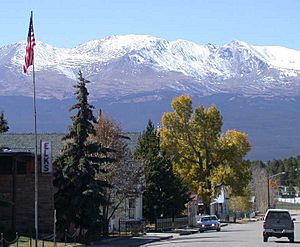
Parks and recreation
Situated within the San Isabel National Forest and surrounded by three wilderness areas, Leadville is popular with hikers and campers. The Mount Massive Wilderness and Buffalo Peaks Wilderness are within 10 miles (16 km) of the city, and the Collegiate Peaks Wilderness is within 20 miles (32 km).
Mosquito Pass is located east of Leadville. It can be traversed only on foot, an off-road motorcycle, or with a proper four-wheel drive vehicle. It is typically passable only during the summer months.
The Mineral Belt Trail is an 11.6-mile (18.7 km), two-way non-motorized paved trail around the city that was opened in 2000. Five access points offer opportunities to walk shorter sections: Ice Palace Park, Lake County Middle School, Dutch Henry Hill, California Gulch, and the East 5th Street Bridge. Mineral Belt is completely ADA-accessible for wheelchairs and strollers, cyclists, runners and in-line skaters.
Education
K-12 Education
Leadville's K-12 education is served by the Lake County School District.
Higher Education
Leadville is home to a campus of Colorado Mountain College. At an elevation of 10,200 feet, CMC Leadville is the highest elevation college campus in the United States. The Leadville campus is also home to Colorado Mountain College's cross-country team.
Infrastructure
Transportation
Leadville is served by Lake County Airport, North America's highest public use airport at an altitude of 9,934 feet. However, there is no scheduled airline service available from this airport. The closest airports to provide scheduled services are Eagle County Regional Airport and Aspen/Pitkin County Airport, both 62 miles (100 km) away.
Highways
 US 24 is an east–west highway running from Interstate 75 near Clarkston, Michigan, to Interstate 70 near Minturn, Colorado. Its western terminus is located just 32 miles (51 km) north of Leadville. It is the main route to the Eagle-Vail valley to the northwest and Colorado Springs, 128 miles (206 km) to the southeast.
US 24 is an east–west highway running from Interstate 75 near Clarkston, Michigan, to Interstate 70 near Minturn, Colorado. Its western terminus is located just 32 miles (51 km) north of Leadville. It is the main route to the Eagle-Vail valley to the northwest and Colorado Springs, 128 miles (206 km) to the southeast. State Highway 91 is a 22.5-mile (36.2 km) highway that connects Leadville with Interstate 70 near Copper Mountain. It is the quickest route to get from Leadville to Denver, 100 miles (161 km) away.
State Highway 91 is a 22.5-mile (36.2 km) highway that connects Leadville with Interstate 70 near Copper Mountain. It is the quickest route to get from Leadville to Denver, 100 miles (161 km) away.- The Top of the Rockies Byway, designated a National Scenic Byway in 1998, is a highway that travels 75 miles (121 km) starting in Aspen and traveling through Leadville to either Minturn or Copper Mountain.
Railways
- On July 22, 1880, the Denver & Rio Grande Railway arrived on a 3 feet (0.91 m) narrow-gauge railway branch from Malta, 4 miles (6 km) to the west. General Grant and his wife were on hand to celebrate the arrival. Third rail was added in 1888, and from 1940 it was only standard gauge. The last 1.8 miles (2.9 km) were abandoned by Union Pacific in 1998. This severed the connection between the Leadville, Colorado & Southern Railroad and the rest of the railroad system. The remaining three miles from Malta have not seen any traffic in many years.
- In the past, D&RG operated branch lines from Leadville to Oro City (1883–1941), Ibex/Chrysolite (1898–1944), Graham Park (1898–1941) and Fryer Hill (1881–1944). Another branch run over Fremont Pass as far as Robinson, Wheeler, and Dillon (1881/2-1923).
- In 1887, the Colorado Midland Railway arrived in Leadville.
- The former Colorado & Southern Railway line from Leadville to Climax is now operated as a tourist line by the Leadville, Colorado & Southern Railroad.
- In 2010, rail and coach commuter service was proposed between Minturn and Dotsero, in 2012 from Leadville to Vail and Dotsero with intermediate stations at Minturn, Avon, Eagle and Gypsum.
See also
 In Spanish: Leadville para niños
In Spanish: Leadville para niños



